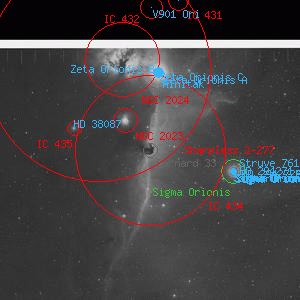IC 434

Overlaid DSS image of IC 434, 120' x 120' with north at top and west to the right
Aladin viewer for the region around IC 434
| Type | Bright Nebula |
|---|---|
| Magnitude | 9 |
| Size | 60' x 10' @ 170° |
| Right Ascension | 5h 40' 59" (2000) |
| Declination | 2° 27' 26" S |
| Constellation | Orion |
| Description | eF, vvL, vmE, 1 deg long incl Zeta Ori |
| Classification | E |
Observing Notes
Andrew Cooper
Jan 12, 2008 Hale Pohaku, Mauna Kea, HI (map)
46cm f/4.5 Deep Violet
Large, faint, a wide swath of nebula dropping south from ζOri, more sharply defined on the east side, west side very indistinct, about halfway down the dark notch of the Horsehead (B33) cuts 5' into the east side, about 2 fields 1° long north to south, NGC2023 visible 10'east
Andrew Cooper
Nov 23, 2006 Las Cienegas NCA, Pima Co., AZ (map)
46cm f/4.5 Deep Violet
Very faint band of nebulosity dropping south from Zeta-Ori, about 10' wide and over 1° long, broken by the dark nebula B33 (The Horsehead)
Harold Corwin
IC 434 is the diffuse emission nebula against which the Horsehead Nebula is superposed. Brian Skiff and I have simply taken the approximate center of the Horsehead itself as the position of the entire nebula.
Even though Dreyer gives Pickering credit for discovering this nebulosity and eleven others in the Orion area: IC 420, 421, 423, 424, 426-428, 430-432, and 435, Steve Waldee and Martha Hazen point out (in PASP 102, 1337, 1990) that all of these were actually found by Williamina Fleming. I suspect that Dreyer simply used Pickering's name as the author of the paper describing the discovery. But -- speculation now -- this could well be a manifestation of the pervasive bias, perhaps so deeply embedded as to be unconcious, against women in the sciences in Dreyer's day. Times were different, then.
Reading this again in June 2018, I think it fair to point out that Dreyer did the same thing with Brother Ferrari's discovery of nebulae at the Collegio Romano (NGC 7667, etc), crediting them in the NGC to Father Secchi who published the paper announcing their discovery. Adopting the name of the paper's authors -- who just happened to be the observatory directors -- may have simply been a matter of acknowledging the hierarchy in the institutions, or the seniority of the authors themselves. Another possibility is that papers by junior observing staff were required to be communicated by the senior staff.
Whatever happened, Fleming describes the nebula (it is No. 21 in Pickering's paper in the Harvard Annals, Vol. 18, p. 113, 1890) as "A large nebulosity extending nearly south from [zeta] Orionis for about 60'. More intense and well marked on the following side, with a semicircular indentation 5' in diameter 30' south of [zeta]."
Correspondence with Steve Waldee during 2013 has led to another note about the discovery of the Horsehead. Some people have suggested that it was actually found by WH. This is not true; WH's comment (see Latusseck, J. Astron. Data 14, 4, 2008 where it is reprinted) "Wonderful black space included in Nebulosities" refers to NGC 2024, not to IC 434.
A personal aside: When I was a student at the University of Kansas first learning the formalities of this astronomy business, one of my fellow students noticed that the dark nebula in IC 434 was even more representational of a horse seen tail-end on, looking over his left shoulder at us. The "tail" is the faint whisp of nebulosity stretching east-west in the southern part of the dark patch. My fellow student (who shall go unnamed here) of course called the nebula the "Horse's [Tail] Nebula." I have to admit that this image has stuck in my selective memory all these years, and that I am just enough of a prude in public to disguise the part of the horse's anatomy that my colleague actually referred to.
Finally, I want to note that Fleming has listed eight other "nebulae" that she found on at least one plate that she could not confirm on three others. Only one of these is potentially a real nebula, her number 8 at 05 26.0, -01 56 (B1855.0). She describes it as a "Narrow line about 10' long, doubtless a defect of Plate 2312." At her position is the southern end of a much larger nebulosity centered near 05 33 27, -01 50 (J2000); the brightest portion of it is approximately 11.5 x 6.5 arcminutes in extent, and it appears slightly patchy. It's appearance on the DSS plates does not agree well with Fleming's description, so I do not think it is the object she recorded. I also note that she examined four plates of the area, and found this object on only one of them. So, unlike the nebula hosting the Horsehead, this one is almost certainly a defect. (Someday, we'll be able to examine the Harvard plates online to check all these potential defects, but that day is not yet here. June 2018).
Other Data Sources for IC 434
Associated objects for IC 434
Nearby objects for IC 434
24 objects found within 60'
Credits...
Drawings, descriptions, and CCD photos are copyright Andrew Cooper unless otherwise noted, no usage without permission.
A complete list of credits and sources can be found on the about page
IC 434